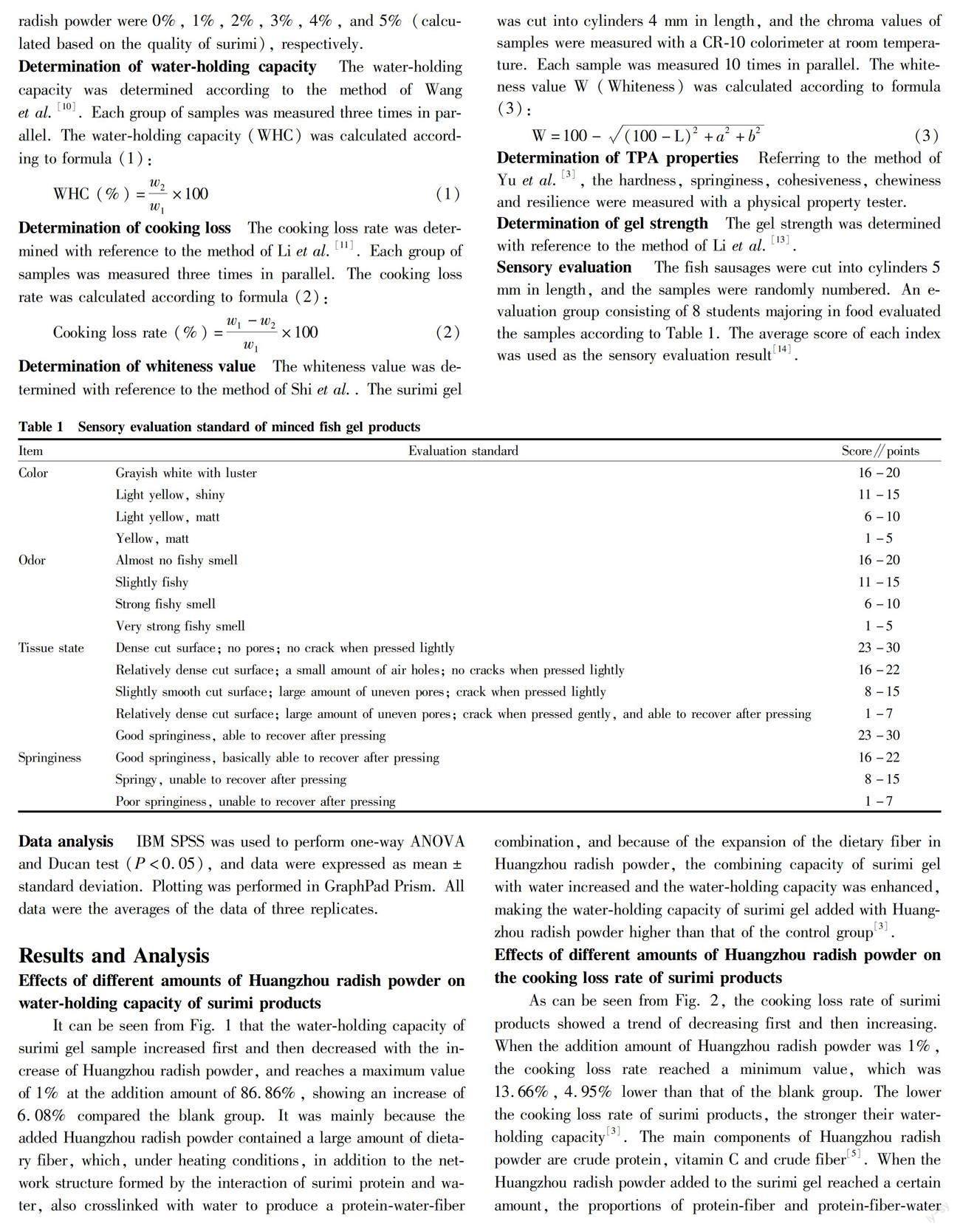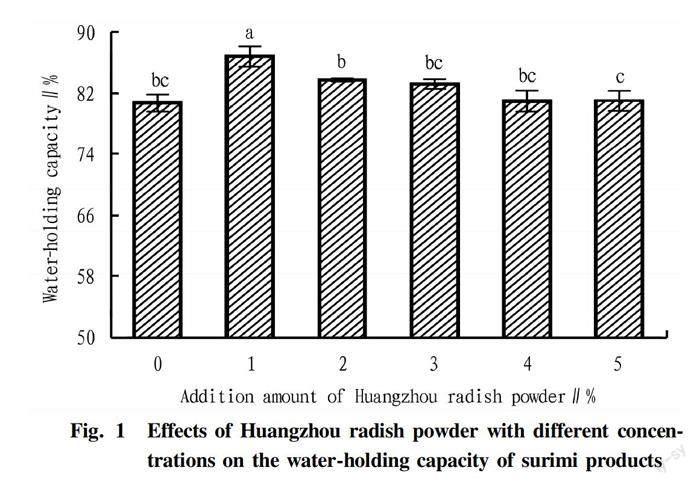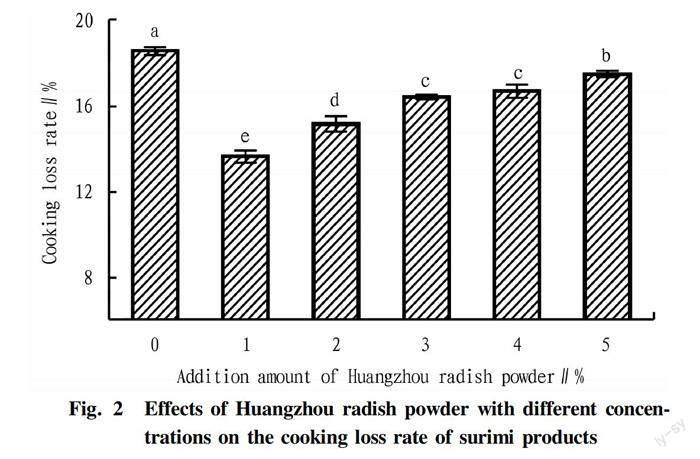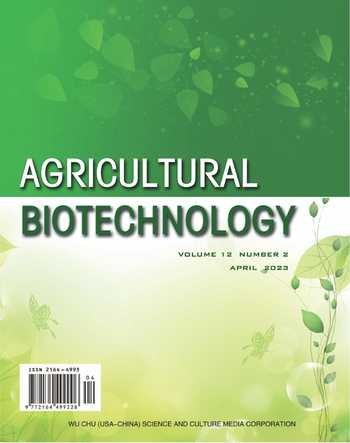Effects of Huangzhou Radish Powder on the Quality of Silver Carp Surimi Products
Qi YANG, Xiaohong LIU, Xinghui TIAN, Yujuan JIN, Yanyu YANG, Fa QIU, Siyao MA, Peng WU, Ting HU



Abstract [Objectives] This study was conducted to improve the quality of frozen silver carp surimi products. [Methods] Huangzhou radish powder and silver carp surimi were used as raw materials to analyze the effects of different amounts (1%, 2%, 3%, 4%, 5%) of Huangzhou radish powder on the water-holding capacity, cooking loss rate, whiteness value, TPA, gel strength and sensory quality of surimi products. [Results] When the addition amount of Huangzhou radish powder was 1%, water-holding capacity, hardness, chewiness and the gel strength of the surimi product reached their maximum values, which were 86.86%, 3 470.36 g, 2 628.50 g and 707.48 g·mm, respectively. Meanwhile, the cooking loss rate was reduced to a minimum value (13.66%), and the sensory quality reached the best. The whiteness of surimi products showed a decreasing trend with the increase of the addition amount of Huangzhou radish powder. However, the whiteness of the surimi product was not significantly affected when the addition amount of Huangzhou radish powder was 1%. Therefore, when the addition amount of Huangzhou radish powder was 1 %, the quality of surimi products could be improved. [Conclusions] This study provides a new idea for the development and utilization of Huangzhou radish.
Key words Huangzhou radish; Surimi product; Quality; Gel strength
Received: December 6, 2022 Accepted: February 7, 2023
Supported by Scientific Research Program Guiding Project of the Education Department of Hubei Province (B2020166); Special Projects of the Central Government Guiding Local Science and Technology Development (2018ZYYD019).
Qi YANG (2001-), male, P. R. China, major: food science and engineering.
*Corresponding author. E-mail: 843076915@qq.com.
As one of the "four major Chinese carps", silver carp have a long history of breeding, and large production, and the meat tastes fresh, tender, delicious and mild[1]. Fish surimi products have the advantages of delicious taste, unique taste, low oil content, and high nutritional value[2]. Silver carp are an ideal material for processing into surimi because of its tender meat and high processing cost performance. However, silver carp surimi has the problem of difficult gel formation, and the gel is prone to deterioration[3]. Therefore, the quality of products made from silver carp surimi is slightly poorer than other surimi products.
Huangzhou radish, as a unique cultivar in Huanggang City, Hubei Province, has a long cultivation history and is known as one of the "Three Wonders of Ancient Huangzhou"[4]. Huangzhou radishes are thick and strong, resembling a winter melon, and are rich in crude fiber, vitamin C, and protein. Therefore, Huangzhou radishes can be used as a main source of dietary fiber[5]. Dietary fiber has good functional properties, such as lowering blood sugar, regulating intestinal flora, and preventing intestinal diverticulosis. It also has good water- and oil-retention properties and other process characteristics[6-7].
Currently, Cheng et al.[7] have found that adding soybean dietary fiber to surimi products could improve the texture characteristics of surimi products. Zhao et al.[8] have found that adding an appropriate amount of soybean dietary fiber to surimi products can not only improve the nutrition of surimi products, but also improve their texture characteristics and reduce their processing costs. Huangzhou radish powder is rich in dietary fiber, but its impact on the quality of surimi products is unclear. In this study, Huangzhou radish powder and frozen silver carp surimi were used as raw materials to analyze the effects of different amounts of Huangzhou radish powder on the water-holding capacity, cooking loss rate, whiteness value, TPA, gel strength and sensory quality of surimi products, providing a new idea for the development and utilization of Huangzhou radishes.
Materials and Methods
Experimental materials and instruments
Huangzhou radishes, salt: commercially available; frozen silver carp surimi: Honghu Jingli Aquatic Food Co., Ltd., Hubei Province (AAA grade); PDVC casing: Qingyun Yijie Plastic Products Co., Ltd., Shandong Province.
TA-XT Plus physical property tester: Texture Technologies Co., Ltd., USA; H/T18MM desktop high-speed centrifuge: Hunan Herexi Instrument & Eqipment Co., Ltd.; HS153 halogen moisture meter: Mettler Toledo Corporation; CR-10 colorimeter: Konica Minolta.
Methods
Preparation of Huangzhou radish powder
Fresh Huangzhou radishes that were free of disease and pests, mildew, and black spots were selected as the raw material. The radishes were washed, and the outer skin of the green part of each radish was removed. The treated radishes were washed again, and the water was drained after cleaning. Next, the radishes were cut into about pieces of 6.0 cm×6.0 cm×2.0 cm, which were dried in an oven at 55 ℃. The dried radish pieces were made into powder, which was sieved with an 80 mesh sieve to obtain Huangzhou radish powder.
Preparation of surimi gel
The reparation of surimi gel referred to the method of wang et al.[9]. The addition amounts of Huangzhou radish powder were 0%, 1%, 2%, 3%, 4%, and 5% (calculated based on the quality of surimi), respectively.
Determination of water-holding capacity
The water-holding capacity was determined according to the method of Wang et al.[10]. Each group of samples was measured three times in parallel. The water-holding capacity (WHC) was calculated according to formula (1):
WHC (%)=w2w1×100(1)
Determination of cooking loss
The cooking loss rate was determined with reference to the method of Li et al.[11]. Each group of samples was measured three times in parallel. The cooking loss rate was calculated according to formula (2):
Cooking loss rate (%)=w1-w2w1×100(2)
Determination of whiteness value
The whiteness value was determined with reference to the method of Shi et al.. The surimi gel was cut into cylinders 4 mm in length, and the chroma values of samples were measured with a CR-10 colorimeter at room temperature. Each sample was measured 10 times in parallel. The whiteness value W (Whiteness) was calculated according to formula (3):
W=100-(100-L)2+a2+b2(3)
Determination of TPA properties
Referring to the method of Yu et al.[3], the hardness, springiness, cohesiveness, chewiness and resilience were measured with a physical property tester.
Determination of gel strength
The gel strength was determined with reference to the method of Li et al.[13].
Sensory evaluation
The fish sausages were cut into cylinders 5 mm in length, and the samples were randomly numbered. An evaluation group consisting of 8 students majoring in food evaluated the samples according to Table 1. The average score of each index was used as the sensory evaluation result[14].
Data analysis
IBM SPSS was used to perform one-way ANOVA and Ducan test (P<0.05), and data were expressed as mean±standard deviation. Plotting was performed in GraphPad Prism. All data were the averages of the data of three replicates.
Results and Analysis
Effects of different amounts of Huangzhou radish powder on water-holding capacity of surimi products
It can be seen from Fig. 1 that the water-holding capacity of surimi gel sample increased first and then decreased with the increase of Huangzhou radish powder, and reaches a maximum value of 1% at the addition amount of 86.86%, showing an increase of 6.08% compared the blank group. It was mainly because the added Huangzhou radish powder contained a large amount of dietary fiber, which, under heating conditions, in addition to the network structure formed by the interaction of surimi protein and water, also crosslinked with water to produce a protein-water-fiber combination, and because of the expansion of the dietary fiber in Huangzhou radish powder, the combining capacity of surimi gel with water increased and the water-holding capacity was enhanced, making the water-holding capacity of surimi gel added with Huangzhou radish powder higher than that of the control group[3].
Effects of different amounts of Huangzhou radish powder on the cooking loss rate of surimi products
As can be seen from Fig. 2, the cooking loss rate of surimi products showed a trend of decreasing first and then increasing. When the addition amount of Huangzhou radish powder was 1%, the cooking loss rate reached a minimum value, which was 13.66%, 4.95% lower than that of the blank group. The lower the cooking loss rate of surimi products, the stronger their water-holding capacity[3]. The main components of Huangzhou radish powder are crude protein, vitamin C and crude fiber[5]. When the Huangzhou radish powder added to the surimi gel reached a certain amount, the proportions of protein-fiber and protein-fiber-water crosslinked systems in the surimi products increased, making the gel network more compact and the ability of water molecules to move, transfer and evaporate in surimi gel decreased, thereby reducing the cooking loss rate of surimi products. Meanwhile, with the excessive addition of Huangzhou radish powder, the cross-linking effects of protein-water and water-fiber structures in the network structure of surimi gel products were reduced[7], which led to the reduction of the stability of gel structure and the increase of cooking loss rate. Therefore, the best effect was achieved when the addition amount of Huangzhou radish powder was 1%.
Effects of different amounts of Huangzhou radish powder on the whiteness value of surimi products
Color is one of the indicators for evaluating the quality of surimi products. Whiteness can directly reflect the color and appearance of surimi products[15]. As can be seen from Fig. 4, the whiteness value of surimi products was negatively correlated with the amount of Huangzhou radish powder added. When the amount of Huangzhou radish powder gradually increased, the whiteness value of the sample group gradually decreased, which was presumably related to the yellow color of Huangzhou radish powder itself. As can be seen from Fig. 3, after adding Huangzhou radish powder to surimi, the brightness of surimi products gradually decreased, and the color gradually turned yellow. When the addition amount was above 3%, the whiteness value of the surimi product was at a lower level, showing significant visual differences. It could be inferred that the addition of radish powder in surimi should be appropriate, otherwise the evaluation of the products from the visual and sensory aspects will be reduced, thereby reducing consumer demand[15]. When the addition amounts of Huangzhou radish powder was 1%, there was no significant effect on the color of the surimi gel product.
Effects of different amounts of Huangzhou radish powder on TPA properties of surimi products
As can be seen from Table 2, when the addition amount of Huangzhou radish powder increased from 1% to 5%, the hardness and chewiness of surimi products first increased and then decreased, and their maximum values of hardness and chewiness appeared when the addition amount of Huangzhou radish powder was 1%, and were 3 470.36 and 2 628.50 g, respectively. The resilience of surimi products decreased with the increase in the amount of Huangzhou radish powder added. The effects of the amount of Huangzhou radish powder added on the springiness and cohesiveness of surimi products were not significant. The hardness of meat products is positively correlated with their water-holding capacity[16]. Studies have shown that an appropriate amount of dietary fiber can improve the hardness and chewiness of surimi[8]. When the addition amount of Huangzhou radish powder in the surimi product was 1%, the water-holding capacity reached its maximum value, and the hardness also reached its maximum value.
Effects of different amounts of Huangzhou radish powder on gel strength of surimi products
It can be seen from Fig. 5 that when the addition amount of Huangzhou radish powder increased from 1% to 5%, the gel strength of the surimi product showed a trend of increasing first and then decreasing, and the gel strength reached a maximum value of 707.48 g·mm when the addition amount of Huangzhou radish powder was 1%, showing an increase of 40.05 g·mm compared with the control group. The reason might be that the added Huangzhou radish powder contained high dietary fiber, and the cross-linking between dietary fiber and water was enhanced, which reduced the protein-water cross-linking, activated some groups in the protein, promoted the interaction between protein and protein and between protein and fiber, and made the surimi gel form a stable network through cross-linking, thus enhancing the gel strength of surimi products[7].
Effects of different amounts of Huangzhou radish powder on sensory quality of surimi products
As can be seen from Table 4, when the amount of Huangzhou radish powder added increased from 1% to 5%, the sensory score of the surimi product showed a trend of first increasing and then decreasing. When the amount of Huangzhou radish powder added was 1%, the scores and total scores of various indexes (color, tissue, and elasticity) were the highest. It was speculated that when the addition amount of Huangzhou radish powder was 1%, the tissue of the surimi product reached its maximum value, but with the further increase of the addition amount, the color of the surimi product changed more significantly and reduced the gel strength, reducing consumers acceptance. Huangzhou radishes are pink and slightly yellow with a faint fragrance. After being added, they can reduce the fishy smell of surimi[9], not only improving the organizational structure of surimi products, but also reducing the impact of the smell carried by fish products themselves on the senses, and effectively improving the overall quality of the surimi product.
Conclusions and Discussion
When the addition amount of Huangzhou radish powder was 1%, the water-holding capacity, hardness, chewiness and gel strength of the surimi product reached their maximums, while the cooking loss rate reached its minimum, and the whiteness value, springiness, resilience and cohesiveness did not change significantly. As a result, the total sensory score was the highest. In summary, the optimal amount of Huangzhou radish powder added to silver carp surimi products was 1%.
References
[1] QIN Y, OU CR, GAO YW, et al. Research progress on gel properties of surimi products[J]. Acta Agriculturae Nucleatae Sinica, 2015, 29(9): 1766-1773. (in Chinese).
[2] WANG L, FAN DM, HUANG JL, et al. Effect of different broken methods on gel structure of silver carpsurimi [J]. Food and Machinery, 2018, 34(3): 32-38. (in Chinese).
[3] YU S, LIU ZY, CHEN SY, et al. Effects of bergamot yam powder on the quality of silver carp surimi products [J]. Food Science and Technology, 2021, 46(1): 139-144. (in Chinese).
[4] LUO JL. Modern development and countermeasures of Huangzhou radish industry[J]. Modern Agricultural Science and Technology, 2012(22): 310, 312. (in Chinese).
[5] CHEN QS, WANG SL, ZHENG XG, et al. Study on developmental strategy of geographical indication products "Huangzhou Radish"[J]. Hubei Agricultural Sciences, 2012, 51(20): 4664-4666, 4670. (in Chinese).
[6] ZHANG XK, XIONG QF, LI SS, et al. Study on a new hybrid breeding between Raphanus sativus and Brassica juncea by distant hybridization[J]. Acta Agriculturae Jiangxi, 2012,24(11): 1-4, 7. (in Chinese).
[7] CHENG ZZ, ZHAO W, YANG RJ. Effect of different dietary fiber on mechanical properties of surimi gels from ribbonfish[J]. Food and Machinery, 2011, 27(6): 75-79, 91. (in Chinese).
[8] ZHAO HL, LI T, XU YX, et al. Effect of Okara powder on gel quality of silver carp surimi [J]. Packaging and Food Machinery, 2018, 36(6): 10-15. (in Chinese).
[9] WANG L, LIU Y, WANG YY, et al. Effects of the amount of chestnut powder added on the quality of silver carp surimi products[J]. The Food Industry, 2021, 42(4): 43-47. (in Chinese).
[10] WANG C. Synergistic effect of starch and hydrocolloids on gel properties of silver carp surimi [D]. Jinzhou: Bohai University, 2019. (in Chinese).
[11] LI X. Effects of broken methods on surimi gel properties[D]. Wuhan: Huazhong Agricultural University, 2014. (in Chinese).
[12] SHI ZZ, CHEN SS, WANG H. Effect of egg white on gel properties of silver carp surimi [J]. Food and Fermentation Industries, 2015, 41(12): 70-74. (in Chinese).
[13] LI W, CHENG D, YANG H. Effects of secondary heat treatment on the quality of silver carp surimi products[J]. Journal of Huazhong Agricultural University, 2019, 38(2): 94-101. (in Chinese).
[14] LIU Y, LI YL, XU DY, et al. Study on optimizing the formula of sweet potato leaf and glutinous rice cake[J]. Journal of Liaoning Agricultural Technical College, 2014, 16(6): 4-5. (in Chinese).
[15] ZHANG SW. Effects of celery on gel quality and in-vitro digestibility of surimi products[D]. Jinzhou: Bohai University, 2019. (in Chinese).
[16] WANG LY. Study on Stability improvement of surimi by konjac glucomannan/protease[J]. Farm Products Processing, 2021(5): 35-39. (in Chinese).
- 农业生物技术(英文版)的其它文章
- Improving the Heat Resistance of β-1,4 Glucanase by Introducing Disulfide Bonds
- Comparative Study on Biological and Commercial Characteristics of Mul-tiple Varieties of Broccoli (Brassica oleracea L. var. italica Plenck) and Vegetable Soybean (Glycine max (L.) Merr.)
- Effects of Bamboo Charcoal-based Biochar on Soil Enzyme Activity and Microbial Community Structure
- Summary of Short-vine Watermelon Breeding Practice
- Effects of Combined Application of Biochar-based Organic Fertilizer and Reduced Nitrogen Fertilizer on Soil Enzyme Activity and Yield of Purple Cabbage (Brassica oleracea var. capita rubra)
- Effects of Microelement Fertilizers on Main Economic Characters and Yield of Peanut

